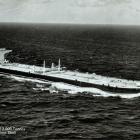The Singapore Strait—a 113-kilometer-long, 19-kilometer-wide strait between the Malacca Strait and the South China Sea—is often described as one of the most crucial sea lanes for merchant ships in global trade. It is the only deep-water passage to the Port of Singapore, the world’s second-busiest port in terms of total shipping tonnage, and is known as a conduit for a significant portion of the world’s oil trade.
Yet, within this corridor of commerce, maritime incidents (e.g., ship collisions, fire, machinery damage, and sinking/grounding) are frequently observed, which in turn impact on the environment, particularly when tankers are involved and oil spills occur. Among these is the Myrtea oil spill of 1972, which, despite being largely forgotten and scarcely documented, was one of the earliest “large” oil spills (exceeding 600,000 liters) by a “Very Large Crude Carrier” (VLCC) supertanker in the Strait—at a time when concurrent global oil spills were increasing public awareness and calls for the regulation of such tankers.
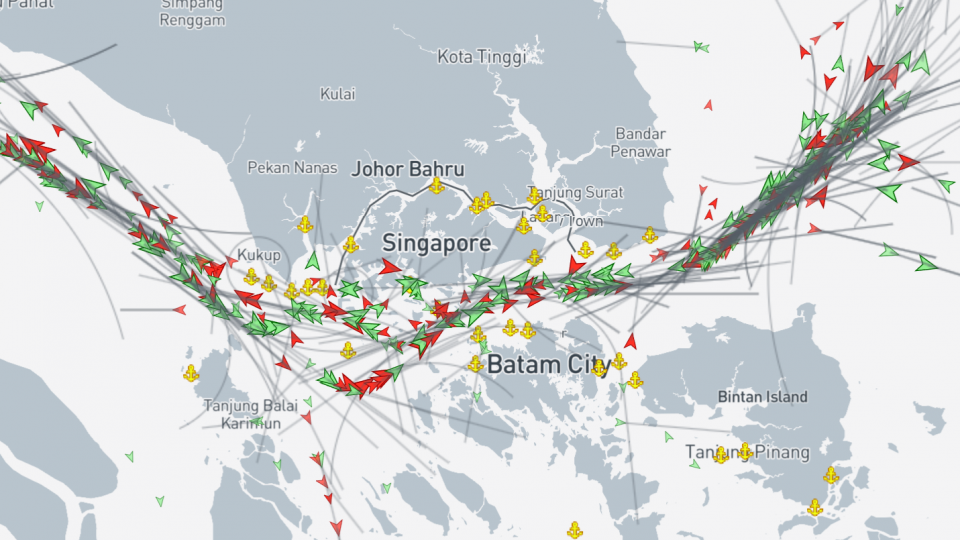
Screenshot of a live map showing underway cargo vessels (green) and tankers (red), as well as their projected course (grey), in the Singapore Strait on 6 March 2024, at 6 a.m. local time.
Screenshot of a live map showing underway cargo vessels (green) and tankers (red), as well as their projected course (grey), in the Singapore Strait on 6 March 2024, at 6 a.m. local time.
Map taken from MarineTraffic. http://www.marinetraffic.com/.
The copyright holder reserves, or holds for their own use, all the rights provided by copyright law, such as distribution, performance, and creation of derivative works.
On the night of 25 June 1972, the Myrtea, a VLCC owned and operated by the French company Société Maritime Shell (Shell), sailed from the Middle East and ran aground at around 11:00 p.m. about half a mile west of Pulau Bukom—the location of Shell’s then-biggest refining-petrochemical complex. The cause of the grounding is not known but it resulted in a breach of the ship’s hull, leading to an estimated leakage of 850,000 liters of crude oil into the surrounding sea. The full extent of the spill only became apparent at sunrise, when a three-kilometer-long oil slick, driven by strong currents, was found to be making its way toward the shores of mainland Singapore. The consequences were far-reaching, contaminating the beaches of Bedok, Changi, Loyang, and Tanah Merah.
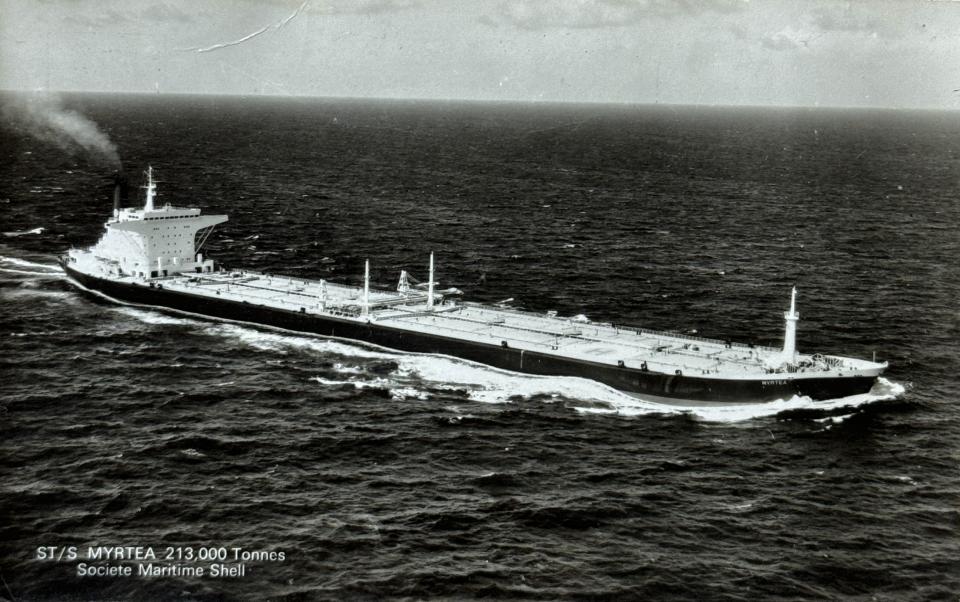
Photograph of the Myrtea. Being a “Very Large Crude Carrier” (VLCC), it was one of the first oil tankers above 200,000 tons deadweight—a measure of how much weight a ship can carry, as a sum of cargo, fuel, fresh water, ballast water, provisions, passengers, and crew—that began to dominate the world’s shipping lanes during the early 1970s.
Photograph of the Myrtea. Being a “Very Large Crude Carrier” (VLCC), it was one of the first oil tankers above 200,000 tons deadweight—a measure of how much weight a ship can carry, as a sum of cargo, fuel, fresh water, ballast water, provisions, passengers, and crew—that began to dominate the world’s shipping lanes during the early 1970s.
Unknown photographer, n.d.
From the private archive of Miklas P. Sauermann.
Despite authorities undertaking immediate and large-scale cleansing operations with 75,000 liters of dispersants (later found to be highly toxic through field and laboratory studies at other marine oil spill sites; see the 1967 Torrey Canyon and 1969 Santa Barbara incidents), coupled with the efforts of hundreds of soldiers, firefighters, public health workers, and civilians, it took one week to bring the spill under control, at a cost of around four million Singapore dollars (inflation-adjusted).
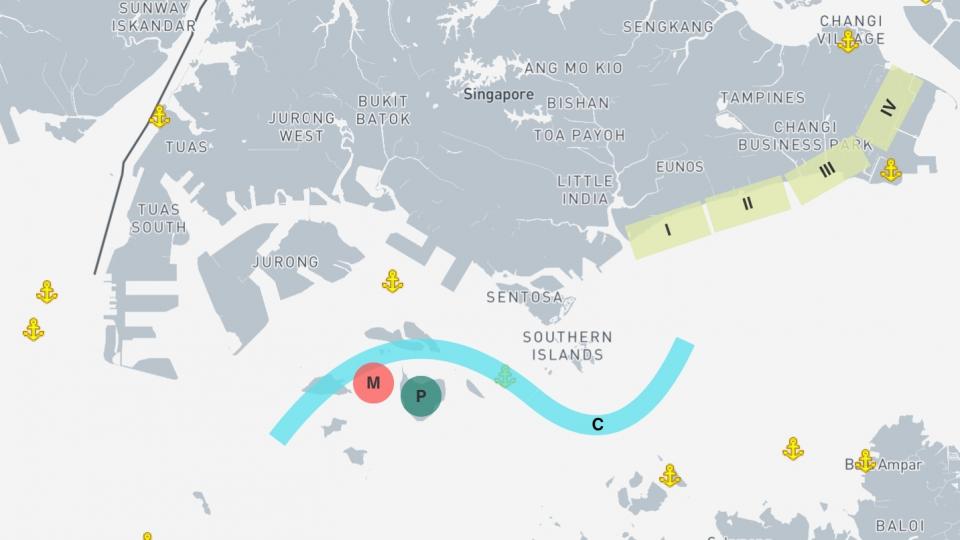
Map of Singapore detailing the Myrtea oil spill area, with the grounding location (M), Pulau Bukom (P), tidal currents from West to East (C), and affected beaches Bedok (I), Changi (II), Loyang (III), and Tanah Merah (IV) (based on the 1972 shoreline).
Map of Singapore detailing the Myrtea oil spill area, with the grounding location (M), Pulau Bukom (P), tidal currents from West to East (C), and affected beaches Bedok (I), Changi (II), Loyang (III), and Tanah Merah (IV) (based on the 1972 shoreline).
Map taken from MarineTraffic. http://www.marinetraffic.com/.
The copyright holder reserves, or holds for their own use, all the rights provided by copyright law, such as distribution, performance, and creation of derivative works.
The incident left an indelible mark on the environment, specifically its marine ecosystem. The resultant oil slick affected a diverse array of marine life, including key species at various trophic levels, from microscopic plankton to larger fish and marine mammals—a disruption to the food chain with cascading effects, diminishing biodiversity and altering the ecological balance. It also caused damage to sensitive coral reef systems and mangrove forests. Coral reefs, already vulnerable to changes in water quality and temperature, suffered greatly from the oil’s suffocating presence, leading to reduced coral cover and the loss of habitat for reef-associated species. Moreover, the mangrove forests around Bedok and Changi, with their ecological significance (e.g., essential for shoreline stabilization and as nurseries for various species), experienced severe contamination. The physical smothering of their roots and the toxic effects of oil hampered growth and regenerative capabilities, leading to a decline in mangrove health and coverage.
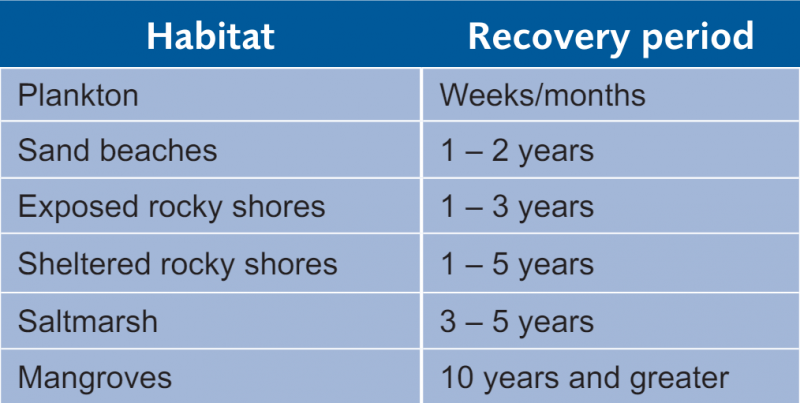
Indicative recovery periods after oiling for various habitats (as observed by ITOPF), dependent on the amount and type of oil spilled. Recovery is defined here as the point at which the habitat functions normally.
Indicative recovery periods after oiling for various habitats (as observed by ITOPF), dependent on the amount and type of oil spilled. Recovery is defined here as the point at which the habitat functions normally.
© 2014 International Tanker Owners Pollution Federation (ITOPF).
Reproduced with the kind permission of ITOPF as an extract from TIP 13: Effects of oil pollution on the marine environment.
The copyright holder reserves, or holds for their own use, all the rights provided by copyright law, such as distribution, performance, and creation of derivative works.
Marine ecosystems can reestablish themselves over time; however, natural variability makes achieving pre-spill conditions highly unlikely. Similar to what was observed at the 1967 Torrey Canyon incident site, shore ecosystems/habitats (e.g., mangrove forests, coral reefs, sand beaches, exposed rocky shores) have shown signs of recovery from the oil within a few seasonal cycles, as indicated below, although with reduced robustness due to the narrow age range of new plants and animals. Moreover, it is to be expected that residual effects persist despite recovery, especially in long-lived species with low reproductive rates.
Given the environmental impact of the 1972 Myrtea incident, in addition to concurrent global oil spills and the increasing number of supertankers roaming the Strait, Singapore ratified the 1973 International Convention for the Prevention of Pollution from Ships (MARPOL)—the main convention covering prevention of marine pollution by ships from operational or accidental causes. Shortly after, the Prevention of Pollution of the Sea Act (Prevention Act) was enacted for Singapore’s accession to MARPOL, not only to specify measures to prevent deliberate, negligent, or accidental discharge of oil or other harmful substances from ships but also to establish a framework for proactive measures to safeguard the marine environment.
Under the Prevention Act, the Maritime and Port Authority of Singapore (MPA) was empowered to enforce environmental regulations, gaining the authority to deny entry to or detain ships that failed to comply with these standards, as well as to update its National Oil Spill Contingency Plan, integrating measures from the International Convention on Oil Pollution Preparedness, Response and Co-operation. This included the early adoption of protocols for rapid response and coordination during oil spill incidents, which, although not as technologically advanced as later developments, represented significant progress for that time. The plan emphasized preparedness through regular training, the establishment of designated response teams, and protocols for inter-agency collaboration, such as with the Singapore Civil Defence Force, ensuring that Singapore was better equipped to prevent and respond to marine pollution.
However, despite these efforts, the Singapore Strait continued to witness similar or even larger oil spills, highlighting ongoing challenges in managing environmental risks. Notable incidents include the Monemvasia in 1983 (3.6 million liters), the Century Dawn in 1988 (11.7 million liters), and the collision between the Evoikos and the Orapin Global in 1997 (24.0 million liters), as well as more recent ones, such as the Alyarmouk in 2015 (3.8 million liters).
Source Acknowledgment
The analysis and insights presented in this article are grounded in comprehensive research conducted within the official archive of Singapore newspapers maintained by the National Library Board, Government of Singapore. The archival materials provided a factual basis for reconstructing the events surrounding the 1972 Myrtea oil spill, ensuring the accuracy and integrity of the historical account detailed herein.
How to cite
Sauermann, Miklas. “From Crisis to Action: The 1972 Myrtea Oil Spill in the Singapore Strait.” Environment & Society Portal, Arcadia (Summer 2024), no. 9. Rachel Carson Center for Environment and Society. doi:10.5282/rcc/9840.
ISSN 2199-3408
Environment & Society Portal, Arcadia
 This work is licensed under a Creative Commons Attribution 4.0 International License.
This work is licensed under a Creative Commons Attribution 4.0 International License.
2024 Miklas Sauermann
This refers only to the text and does not include any image rights.
Please click on an image to view its individual rights status.
- Capon, Craig J. “The Threat of Oil Pollution in the Malacca Strait: Arguing for a Broad Interpretation of the United Nations Convention on the Law of the Sea.” Washington International Law Journal 7, no. 1 (1998): 117–41.
- Chan, Eng Soon, Pavel Tkalich, Karina Yew-Hoong Gin, and Jeffrey P. Obbard. “The Physical Oceanography of Singapore Coastal Waters and Its Implications for Oil Spills.” In The Environment in Asia Pacific Harbours, edited by Eric Wolanski, 393–412. Dordrecht: Springer, 2006.
- Loya, Y., and B. Rinkevich. “Effects of Oil Pollution on Coral Reef Communities.” Marine Ecology Progress Series 3, no. 16 (1980): 167–80.
- Mohd Rusli, Mohd Hazmi. “Navigational Hazards in International Maritime Chokepoints: A Study of the Straits of Malacca and Singapore.” Journal of International Studies 8 (2020): 47–75.
- “Oil Transportation by Tankers: An Analysis of Marine Pollution and Safety Measures.” Office of Technology Assessment, Congressional Board (1975).
- Shelton, R. G. J. “Effects of Oil and Oil Dispersants on the Marine Environment.” Proceedings of the Royal Society of London. Series B, Biological Sciences 177, no. 1048 (1971): 411–22.
- Teal, John M., and Robert W. Howarth. “Oil Spill Studies: A Review of Ecological Effects.” Environmental Management 8 (1984): 27–43.



